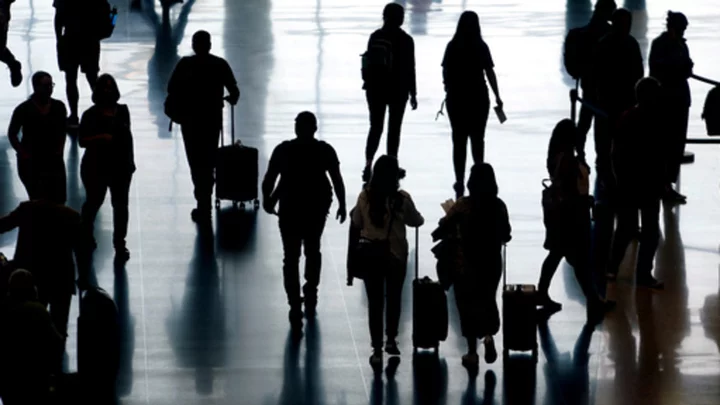Dining out is more expensive than ever. The cost of gas is rising again. And the price of travel — including airfare and hotels — has kept pace. Right?
Not exactly. Airfare costs declined by 13% between September 2022 and September 2023, according to September 2023 Consumer Price Index data from the Bureau of Labor Statistics.
Far from being an inflationary force, travel prices have actually helped cool overall prices this year. Yet this seems to fly in the face of many travelers’ expectations.
“I keep hearing the narrative that it’s so expensive to travel,” says Hayley Berg, lead economist at Hopper, a travel booking platform. “In reality we’re seeing lower prices, for domestic trips especially.”
Travel prices have fluctuated so often since 2019 that it makes sense if recent price drops haven’t registered for many travelers. And while airfare has decreased in recent months below 2019 levels, other expenses such as dining out and renting a car remain above their pre-pandemic baseline.
Put simply: It’s been complicated, yet prices are moderating.
INTERNATIONAL FLIGHTS STILL PRICEY
Part of this complication comes from the divergence in price swings for domestic and international airfare. Overseas travelers have seen starkly higher relative prices than those flying within the U.S.
“On the international front, prices for most destinations are higher than pre-pandemic,” Berg says.
Typical roundtrip fares from the U.S. to Europe hit nearly $1,200 this summer, according to Hopper data, which was the highest price in six years. Tickets to Asia reached almost $1,600. And while Berg says prices have moderated since then, they remain high by historical standards. On the flip side, domestic prices are down compared with 2022.
What’s driving this difference in price trends? The supply of aircraft seats is one issue. Although airlines are now operating at 2019 capacity domestically, they have been slower to add international flights, according to Berg.
Indeed, American Airlines added only 11% more international capacity in the first half of 2023 compared with the same period in 2022, according to its second-quarter financial results, yet revenue increased on those routes by 41%. Clearly, supply hasn’t kept pace with demand, and prices have risen.
Another reason airlines have been able to keep international prices high: a relative lack of competition from low-cost airlines.
“If you think back to 2019, it was the heyday of flying to London for $300 with a stopover in Iceland,” Berg says. “Fast forward to today, many of those airlines are not operating or operating at lower capacity.”
All this points to the same conclusion for budget-minded travelers: Airfare is relatively cheap for U.S. travel and expensive for those flying abroad.
OTHER PRICES FLUCTUATING
Lodging prices have fluctuated less dramatically than airfare over the past two years, though current prices overall are elevated over 2019 and 2022 levels. Average daily rates for U.S. hotels rose by 2% year-over-year in August, according to STR, an industry analyst. Short-term rental prices over the same period were largely flat based on data from AirDNA, a short-term rental analytics company.
The cost of renting a car, which skyrocketed in the past few years, has normalized somewhat. Prices were down 9% in September 2023 compared with the same month last year. And Berg suggests that these trends, too, vary by region.
“In Florida, which is one of the most popular markets, prices are incredibly low,” she says. “Where the supply is, prices are very low.”
Still, car rental prices have much farther to fall before they reach pre-pandemic norms. It now costs 37% more to rent a car than it did in 2019, according to September’s Consumer Price Index.
SHIFTING PRIORITIES
The surge of “revenge travel” in summer 2022 and early 2023 caused prices to spike. Yet these prices peaked in March of this year, according to the NerdWallet travel price index, and have been trending downward ever since.
And while international flights remain expensive, these prices are lowering, according to Berg. The U.S. dollar’s strength against foreign currencies such as the euro and Japanese yen also bodes well for international travel budgets.
All together, this means readjusting (once again) to the new realities of travel costs and letting go of the idea that prices remain elevated. These trends could change again in the face of volatile oil prices and changing consumer demands, but experts expect prices to stay low in the short term.
“Some of the pent-up demand was exhausted this summer,” Berg says. “Regular demand is what we’re seeing going forward.”
________________________
This article was provided to The Associated Press by the personal finance website NerdWallet. Sam Kemmis is a writer at NerdWallet. Email: skemmis@nerdwallet.com.
RELATED LINK:
NerdWallet: Travel Inflation Report https://bit.ly/nerdwallet-travel-inflation-report
Hopper: 2023 Summer Travel to Europe https://media.hopper.com/research/2023-summer-travel-to-europe

